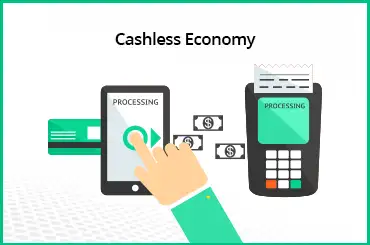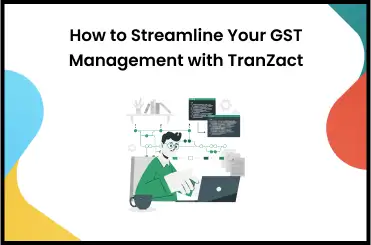Let's find out what is GST number with this blog. Goods and services tax, as defined under article 366(12A), describes GST as 'any tax that applies to goods, services or both'. Goods are defined as all materials, commodities, and articles. Services are defined as anything other than that defined under 'goods'.
In this blog, we will be exploring all the information related to GST or Goods and Service Tax Identification Number like what are GST identification numbers, the benefits of GST numbers, and the process of registration.
What Is GST Number (GSTIN)?
GST stands for Goods and Services Tax. It is a value-added tax that is applicable to the supply of goods and services in India. Every business dealing with the supply of goods or services needs to register for GST and obtain a unique GST identification number (GSTIN). The GSTIN number is important for a business because it enables it to collect and pay GST on its supplies. It also helps in the identification of the business by the government authorities and facilitates a seamless flow of input tax credit across the supply chain. Having understood what is GST number, let's understand more about its format with an example.
GST Number Format and Example
A typical GSTIN structure includes a 15-digit number. It highlights that the taxpayer or business entity is registered under GST. Each digit of the GSTIN has a specific meaning, which is highlighted below:
- State Code: The first two digits of the GSTIN format represent the state code.
- PAN: The next 10 digits of the GSTIN are the Permanent Account Number (PAN) of the taxpayer.
- Entity Code: The 13th digit of the GSTIN represents the entity code. It is based on the number of registrations a taxpayer has within a state.
- Check Digit: The last digit of the GSTIN is the check digit. It is calculated based on the algorithm called the Luhn algorithm.
For example, GSTIN: 29AFGCX101F1Z5
- 29- It is the state code for Karnataka
- AFGCX101F- It is the PAN of the taxpayer
- 1- It is the entity code
- 5- It is the check digit.
Why Do You Need a GSTIN?
If you are a business owner in India, obtaining a GSTIN is mandatory. This becomes especially significant if your business has a turnover of more than Rs. 20 lakhs (the limit is Rs. 10 lakhs for businesses operating in the North-Eastern states of India). There are several reasons why you need a GSTIN:
Legal Requirement: As per GST law, every business dealing in the supply of goods or services needs to register under the GST Act. Failing to do so can draw legal penalties.
Input Tax Credit: With the implementation of GST, businesses can claim an input tax credit for taxes paid on purchases made for business purposes. However, this is only possible if they have registered under GST and have a valid GSTIN.
Compliance: Businesses need to file GST returns and maintain proper accounting records, which helps in maintaining compliance.
Business Expansion: If you plan to expand your business beyond the state in which you are presently operating, then you need to comply with the GST law in other states.
How to Apply for GSTIN?
This section takes you through the steps of registration for GST:
- Visit the official GST portal at https://www.gst.gov.in/.
- Click on the 'Services' tab and select 'Registration' from the drop-down menu.
- Click on 'New Registration' and select the type of taxpayer from the dropdown menu.
- Now enter your details like the legal name, PAN, email address, mobile number, state and district of your business, and other information.
- Now upload the documents like PAN, Aadhaar, bank account details, proof of business place, and others.
- After completing the details, you can submit the applications.
- After this, verification takes place. Once the verification is complete, you will get your GSTIN number.
- You will receive your GSTIN and login credentials on your registered email and mobile number.
Documents Required for GST Registration
- Scanned copy of the PAN Card
- Identity and Address Proof: Aadhaar card, passport, voter ID Card, or driving license
- Photograph: A passport-sized photograph.
- Proof of Business Address: Rent agreement, property tax receipt or water bill, or electricity bill.
- Bank Statement: Scanned copies of the first page of the bank passbook or a canceled cheque or bank statement as proof of earnings.
- Digital Signature: Necessary for companies and Limited Liability Partnerships (LLPs).
- Letter of Authorization: In the case of an authorized signatory, a letter of authorization or board resolution is required.
GST Portal
To complete the GST registration process, there is a dedicated portal with the name GST portal. Here one can do GST registration, return filing, payment of taxes, and other GST-related compliance activities. It is a one-stop destination where you will get all your answers for GST-related work.
Key services on the GST portal:
- GST Registration: Businesses can apply for GST registration, track the status of their application, and download their GST registration certificate from the portal.
- GST Returns Filing: Registered taxpayers can file their GST returns, including GSTR-1, GSTR-2A, GSTR-3B, and others, online on the portal.
- Payment of Taxes: Businesses can make GST payments online on the GST portal using various modes of payment, including net banking, credit card, and debit card.
- Refunds: Taxpayers can apply for GST refunds and track the status of their refund application on the GST portal.
- Ledger Maintenance: The GST portal maintains a ledger of all taxes paid, credits claimed, and other GST-related transactions.
- Dashboard: The dashboard on the GST portal gives an overview of the entire GST status of an individual. You can check the compliance status, pending returns, payments, and refunds.
- Helpdesk: There is a helpdesk facility that guides the taxpayers and also clarifies their doubts regarding return filing, GST registrations, and other activities.
GST Seva Kendra
GST Seva Kendra is a service center established by the Goods and Services Tax Network (GSTN) to provide assistance and support to taxpayers for GST compliance. These are present at different locations across the country. These centers are managed by the GST Suvidha Providers (GSPs) and GSTN.
The GST Seva Kendras offer a range of services to taxpayers including:
- GST Registration
- GST Returns Filing
- Payment of Taxes
- Refunds
- Training and education on GST laws and compliances
- Grievance Redressal
All-in-all, it plays a pivotal role in promoting GST compliance and assistance. Taxpayers can visit the nearest GST Seva Kendra, or connect with the helpdesk to resolve their queries.
How to Verify GSTIN?
If the need to verify the GSTIN arises, or you want to know what is GST number of a supplier or vendor is, then you can follow these steps to check the GST number authentication:
- Go to the GST portal by logging on to https://www.gst.gov.in/
- Now click on the 'Search Taxpayer' option on the top menu.
- A drop-down menu will pop up. From here, you need to select 'Search by GSTIN/UIN.'
- Now enter the 15-digit GSTIN number that you want to verify.
- A prompt to enter the CAPTCHA code will appear. Enter the details and click search.
- If the GSTIN is valid, the details of the GSTIN holder will appear on the screen. You will also be able to spot the legal name, state, and date of registration.
- If the GSTIN is invalid or not registered, an error message will be displayed on the screen.
If you are planning to do a business transaction with a vendor or supplier, then verifying their GSTIN is paramount.
Benefits of Getting GSTIN
Let's understand why getting a GSTIN is beneficial -
- Legitimacy: The GSTIN gives businesses legal credibility. It helps in building trust with customers, suppliers, and other stakeholders.
- Compliance: GSTIN is mandatory for businesses, and so it helps in adhering to the GST laws, rules, and regulations.
- Input Tax Credit (ITC): Registered businesses with a GSTIN can claim the input tax credit on the GST paid on purchases made for business purposes.
- Access to GST Portal: GST portal is the one-stop destination for all GST-related information. And only businesses with a GSTIN can access the GST portal, which provides various services such as GST registration, return filing, and tax payment.
- Reduced Tax Evasion: The GST system tracks the entire supply chain and ensures that every business in the chain pays its fair share of taxes. This reduces the scope for tax evasion and improves compliance with tax laws.
Difference Between GSTIN and GSTN
GSTIN and GSTN are two different aspects of the GST Law. Let's unfold the difference between the two:
GSTIN- It is a unique 15-digit identification number assigned to businesses that are registered under the GST system. This number has a combination of the PAN of the business, state code, and other information. The first two digits of the GSTIN represent the state code, followed by the 10-digit PAN number, the next digit is the entity code, and the last digit is a check digit. With the help of GSTIN, businesses can track GST-related information.
GSTN- It is a non-profit organization that provides the technological backbone for the implementation of the GST system in India. The objective is to ensure that all the related operations are working seamlessly. The user can log on to the GSTN portal to avail of services like GST registration, return filing, payment, and compliance.
Ensure Your Business Is Compliant With GSTIN
All-in-all, GST has brought an economic revolution to the nation. By now, you know all about what is GST number, and how following the right protocol for GST registration ensures the smooth functioning of the business. TranZact provides GST-compliant documentation so that your business is always aligned with regulatory requirements!
FAQs on GST Number
1. What is the cost of obtaining GST?
As per law, there are no extra charges for GST registration. You can do it free of cost.
2. What is GST ARN?
The ARN is the acronym for Application Reference Number (ARN). It is created when the enrollment application is made at the GSTN Portal. After that, a unique number is provided for doing any transaction at GST System Portal, which is termed the Application Reference Number.
3. What is the GST number used for?
GST number is mandatory to run business operations smoothly in India. A company having a GST number is considered to be credible and authentic. It finds application during the process of filing GST returns, claiming an input tax credit, and compliance with the GST law.
4. Is GST and PAN number the same?
No, goods and services tax (GST) and permanent account number (PAN) are different. In fact, the PAN number is a part of the GST.
5. Who is eligible for GST?
The following are eligible for GST:
- Any business entity like proprietorship, partnership, LLP, private limited company, public limited company, etc.
- Any individual who pays tax
- Non-Resident taxable personsd. E-commerce operators
















